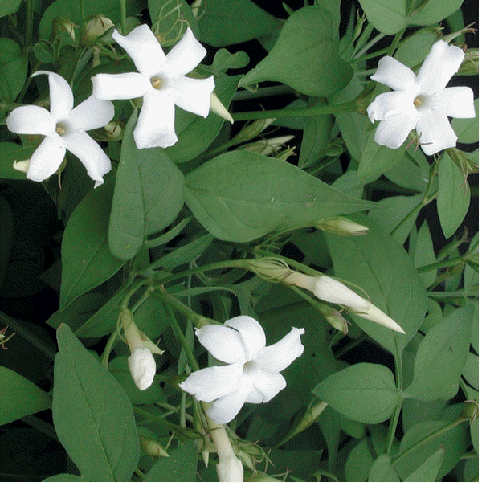Contents:
Common Names | Parts Usually Used | Plant(s) & Culture | Where Found | Medicinal Properties
Legends, Myths and Stories | Uses | Formulas or Dosages | How Sold | Warning | Bibliography
Scientific Names

- Jasminum officinale L.
- Oleaceae
- Olive family
Common Names
- Jasmine plant
- So-hsing (Chinese name)
- Yellow Jasmine
Parts Usually Used
Flowers
Back to Top
Description of Plant(s) and Culture
Jasmine is a vinelike plant that has opposite, dark green, pinnate leaves and sweet-smelling white flowers.
Back to Top
Where Found
Grows in warm parts of the eastern hemisphere and now cultivated in gardens in the southern United States.
Back to Top
Medicinal Properties
Calmative
Back to Top
Legends, Myths and Stories
Jasmine, originating in the Near East, takes its name from the Persian word jesamin. Its beautiful white flower is most famous for the perfumes made from its oil. In the first century AD, Dioscorides, a Greek physician and author of the famous book on medical herbs De Materia Medica, tells us that the Persians used jasmine oil to perfume the air at their banquets. To the Chinese the jasmine symbolizes womanly sweetness. In medieval Christian art, jasmine was associated with the Virgin Mary. Dreaming of jasmine is supposed to portend good fortune, especially in love.
According to folk lore, rubbing the body with the oil of jasmine can be sexually arousing.
Back to Top
Uses
According to old herbals, jasmine flowers calm the nerves. However, others suggest that the scent arouses erotic interests, and a few drops of jasmine oil (if you can afford it) massaged on the body with some almond oil may be soothing. In India, jasmine is used as a remedy for snakebite, and the leaves are used for eye problems.
Other varieties: The Yellow Jasmine (Gelsemium sempervirens) is considered an analgesic, reduces blood pressure, is a sedative, and eases neuralgia. But caution should be noted. An overdose can cause nausea and double vision. One reference states this herb is a powerful CNS-depressant and is a deadly poison. Eating a single flower has resulted in death. It can also cause contact dermatitis.
Jasmine flowers (J. grandiflorum) (Sanskrit name is Jati) is used for emotional disturbances, headaches, fever, sunstroke, conjunctivitis, dermatitis, cystitis, bleeding disorders, bacterial infections, viral infections, cancer of the lymph nodes, cancer of the bones, and Hodgkin’s disease.
Back to Top
Formulas or Dosages
Infusion: steep 1 to 2 tsp. jasmine flowers in 1 cup water. Take 1 cup per day.
Back to Top
How Sold
Many jasmine teas are sold today. Drink 1 cup per day.
Back to Top
Warning
Use this herb under medical supervision.
Back to Top
Bibliography
![]() The Complete Medicinal Herbal
The Complete Medicinal Herbal, by Penelope Ody, Dorling Kindersley, Inc, 232 Madison Avenue, New York, NY 10016, First American Edition, copyright 1993
 Earl Mindell’s Herb Bible
Earl Mindell’s Herb Bible, by Earl Mindell, R.Ph., Ph.D., Simon & Schuster/Fireside, Rockefeller Center 1230 Avenue of the Americas, New York, New York 10020
![]() Indian Herbalogy of North America
Indian Herbalogy of North America, by Alma R. Hutchens, Shambala Publications, Inc., Horticultural Hall, 300 Massachusetts Avenue, Boston, Massachusetts 02115, 1973
![]() Eastern/Central Medicinal Plants
Eastern/Central Medicinal Plants, by Steven Foster and James A. Duke., Houghton Mifflin Company, 215 Park Avenue South, New York, NY 10000
![]() The Herb Book
The Herb Book, by John Lust, Bantam Books, 666 Fifth Avenue, New York, NY. copyright 1974.
![]() The Yoga of Herbs: An Ayurvedic Guide to Herbal Medicine
The Yoga of Herbs: An Ayurvedic Guide to Herbal Medicine, by Dr. David Frawley & Dr. Vasant Lad, Lotus Press, Twin Lakes, Wisconsin, Second edition, 1988.
![]() Webster’s New World Dictionary
Webster’s New World Dictionary, Third College Edition, Victoria Neufeldt, Editor in Chief, New World Dictionaries: A Division of Simon & Schuster, Inc., 15 Columbus Circle, New York, NY 10023
 The Rodale Herb Book: How to Use, Grow, and Buy Nature’s Miracle Plants (An Organic gardening and farming book)
The Rodale Herb Book: How to Use, Grow, and Buy Nature’s Miracle Plants (An Organic gardening and farming book), edited by William H. Hylton, Rodale Press, Inc. Emmaus, PA, 18049., 1974
